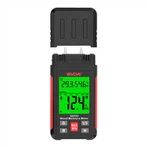A multimeter can only measure conductor resistance and a megohmmeter can measure insulator resistance.
Conductor: An object that conducts electricity well
Insulator: An object with poor electrical conductivity (note, not an object that does not conduct electricity)
Common conductors in our lives include: copper, iron, aluminum, gold, silver, graphite, etc.
Common insulators in our lives include: plastic, rubber, glass, ceramics, pure water, air, various natural mineral oils, etc.
What we need to pay special attention to here is that insulators are objects with poor electrical conductivity, not non-conductive objects. Strictly speaking, absolutely non-conductive objects do not exist. For example, plastics may break down and conduct electricity when the temperature is high. Therefore, insulators are divided into five grades: Y, A, E, B, F, H, and C according to the heat resistance temperature.
Likewise, insulators may break down at higher voltages and thus conduct electricity. Therefore, whether an insulator conducts electricity is relative to a certain voltage. This voltage is called the rated voltage of the insulator.
Logically speaking, whether the wire is burned out has little to do with the voltage. Then why does he still need to mark the rated voltage? This is because the insulation on the outside of the wire has a voltage tolerance range. We can simply understand that when the water pressure exceeds the bearing range of the water pipe, the water pipe will be damaged and the water inside will spurt out. Similarly, when the voltage of the wire exceeds the endurance range of the insulation, the insulation of the wire will be destroyed and the current will flow out, commonly known as "leakage".
Multimeters and Megohmmeters
Measuring resistance with a multimeter actually uses Ohm's law. We all know that when a multimeter measures resistance, the 1.5V and 9V batteries in the meter are powered. When the two test leads are connected to the resistor, the current in the meter starts from the positive terminal of the battery, then passes through the meter head, the resistor, and then returns to the negative terminal of the battery. The size of the resistance can be judged based on the current on the meter, because the voltage is constant and the current depends on the size of the resistance.
For measuring the resistance of conductors, this is no problem at all; but for measuring insulators, it does not work, because whether the insulator conducts electricity depends on voltage and temperature. For example, if an insulator is non-conductive at 9V, then when measured with a multimeter, there will naturally be no current flowing through the meter, so the displayed resistance will be infinite. But if you continue to apply higher voltages, it may break down and conduct electricity. Therefore, when measuring whether an insulator is conductive, a voltage must be specified.
There is a hand-operated DC generator inside the megohmmeter. Depending on the voltage level of the megohmmeter, the output voltage of the generator is also different. A 250V megohmmeter can emit a DC voltage close to 250V, a 500V megohmmeter can emit a DC voltage close to 500V, a 1000V megohmmeter can emit a DC voltage close to 1000V... If you use a 500V megohmmeter to measure a certain The insulation resistance of a wire is simulated under 500V DC voltage to test whether the wire is leaking.
If a line does not leak electricity when measured by a megohmmeter at 500V, it will even less leakage under 300V voltage. Therefore, when we choose a megohmmeter for measurement, we must ensure that the voltage level of the megohmmeter is higher than the actual voltage of the line. In addition, the megohmmeter emits direct current, while the 220V we commonly use is alternating current. The peak value of 220V alternating current can reach 220*1.414=311V. Therefore, we must choose a 500V megger when testing the insulation of AC 220V lines.






